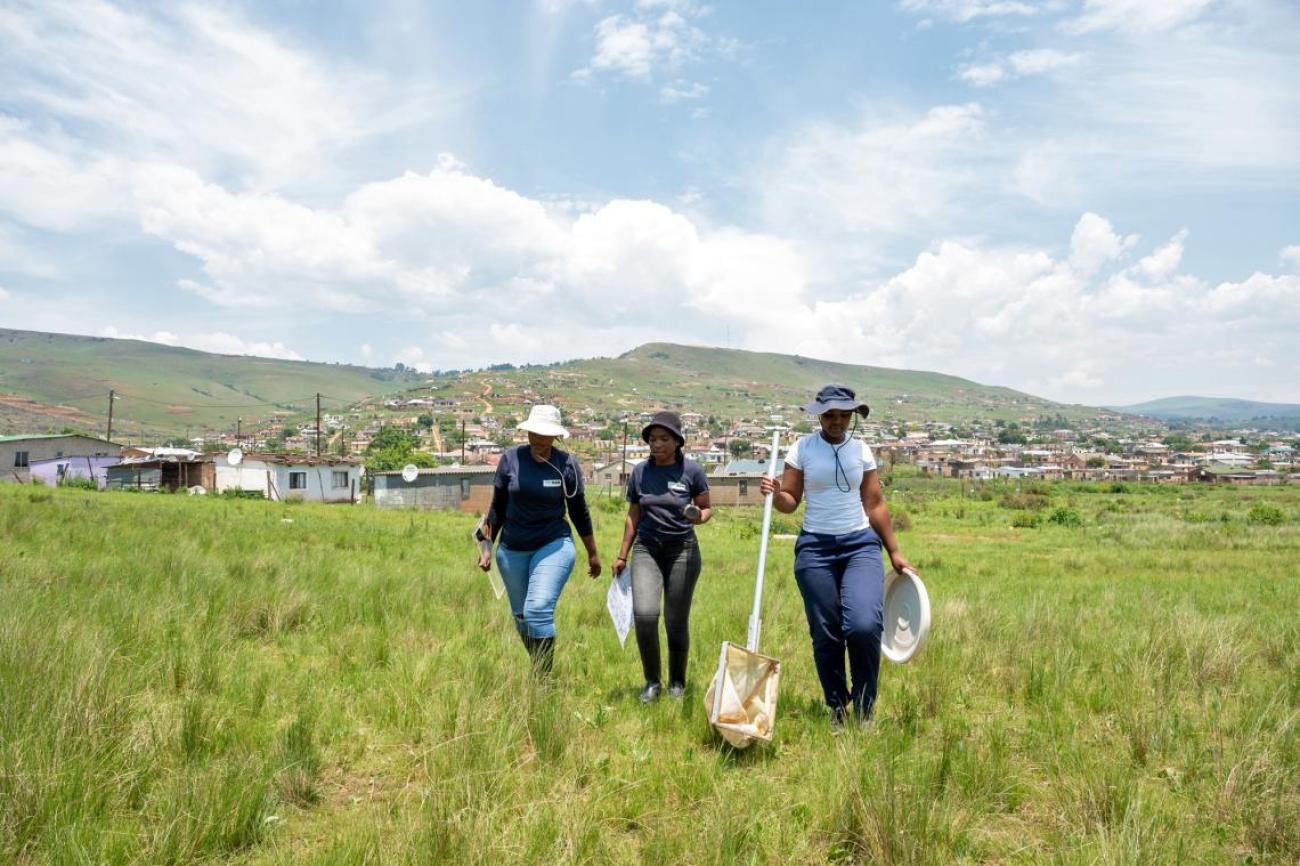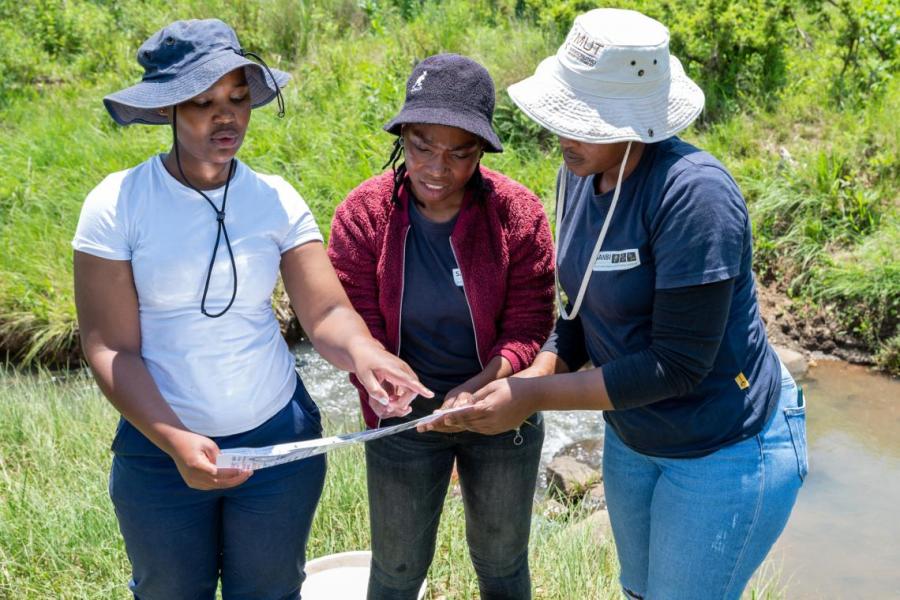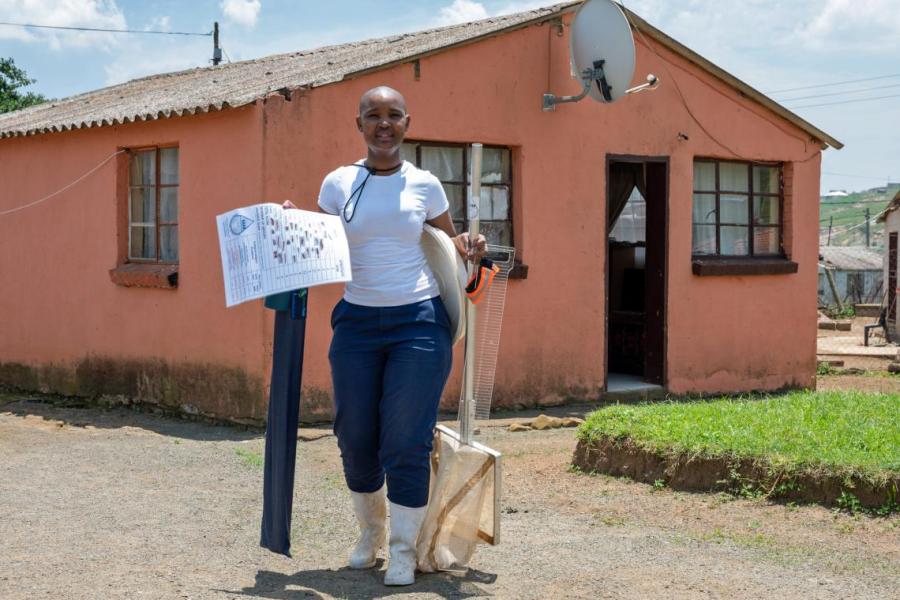Youth on the frontlines protecting South Africa’s environment

‘Enviro-Champs’ - helping to create a healthier environment today and building knowledge and skills for tomorrow.
“We are making sure that the river is kept healthy and clean,” says Palesa, as she wades into Mthinzima stream that skirts the edges of Mpophomeni township. Behind her the rolling hills of northern Kwa Zulu- Natal (KZN) shine bright green following the summer rains.
The 25-year-old is here with two other young women, Mbali and Thabsile, to take a pulse on the quality of the water flowing. The team make-up three of some 500 ‘Enviro-Champs’ determined to protect their local environments.

They meticulously read the stream’s health through a clarity tube and velocity plank that record the solids present in the water and the speed of flow. A sample of water is also taken to identify and match invertebrates on a chart, which further helps to indicate pollution levels. This is the ‘mini-SASS kit’ that provides a holistic picture of water quality, with no laboratory tools needed. The findings are then recorded by the team and verified through the ‘mini SASS’ portal, which can register environmental actions from across the world.
Keeping communities healthy
The significance of Palesa and the teams work in monitoring and recording the Mthinzima stream’s pollution levels has far reaching effects. “This has a further downstream impact, like at the Durban beaches where some of them have been closed because of the waste and pollution from upstream areas,” explains Palesa.
The stream also flows into the nearby Midmar dam and can pollute this body of water that’s a vital resource for communities across Pietermaritzburg and Durban. Keeping water safe, as opposed to cleaning polluted water, can save authorities large sums of money.

“The water quality is not good,” says Palesa after the team read the test results. The next step, to record the findings on the ‘mini-SASS’ website that maps water quality readings. This provides an early warning system for communities and authorities of which bodies of water are polluted and what action may be needed.
Palesa explains that local sewage spillages are the most frequent cause of pollution and the team have previously called on local authorities to fix manholes from where sewage is leaking.
“A cleaner stream can better manage pollution and heal itself even if there is a dose of sewage or pollution but once a stream goes past a tipping point it can’t clean itself,” explains Dr. Mark Graham from GroundTruth who train ‘Enviro-Champs’ and manage the ‘mini-SASS’ webpages.
Building connections from the ground up
In the process of environmental action, the ‘Enviro-Champs’ work with people from across society. “We engage with the community to come up with an idea on how we can solve problems,” says Thabsile, referring to their work in tackling solid waste dumping around the stream and the burning of household rubbish that affects air quality.
Advocacy with the local municipality resulted in more skips being available for households to reduce the amount of rubbish being dumped and incinerated. “People were interested because when the ‘Enviro Champs’ project developed, we were able to bring so many changes,” says Thabsile who started this work back in 2015.
“It provides a social fabric that puts ‘Enviro Champs’ in touch with their ward councilor or community leaders,” explains Dr. Graham. But it’s tough work that requires sustained effort. “Some people are just hard of hearing they don’t want to listen at all. Especially if it’s somebody young who is coming to tell them what to do with their waste, or the river,” says Palesa.
Effective action from authorities also sparks mixed reactions. According to Dr. Graham, “Some ward councilors are very interested and proud of responding, others more indifferent.”

Education, skills and opportunities
The ‘Enviro-Champs’ work helps to create a healthier environment today and builds knowledge and skills for tomorrow, incentivizing young people in the process.
“Kids realize and learn what’s in the water and where the source of pollution is,” says Sim’lindile Mahlaba who works with GroundTruth on the project across KZN. They then learn to compile the findings and how to effectively approach the authorities to present the evidence.
In a country where 64 per cent of young people, aged 15 to 24-years, are not engaged in formal work, education or training, the project provides vital skills building and resources for personal development. “More opportunities have opened up for the youth in the area, they are able to get stipends, they are able to learn more and be kept preoccupied,” says Palesa.
UNICEF South Africa is now supporting the scale-up ‘Enviro-Champs’ across the country, including by recognizing and incentivizing their impact through the Youth Agency Marketplace (YOMA). The platform adds their actions to a digital CV and rewards youth with Zlto digital tokens that can be converted into data, food vouchers and for other practical needs. In addition, YOMA provides access to a suite of digital training resources and can connect youth to employment opportunities.
“The knowledge we gain now we pass it on,” says Palesa reflecting on the broader impact of her work. For the next generation, environmental conservation at the local level will be critical for healthier living and as a gateway to skills and the green economy.






